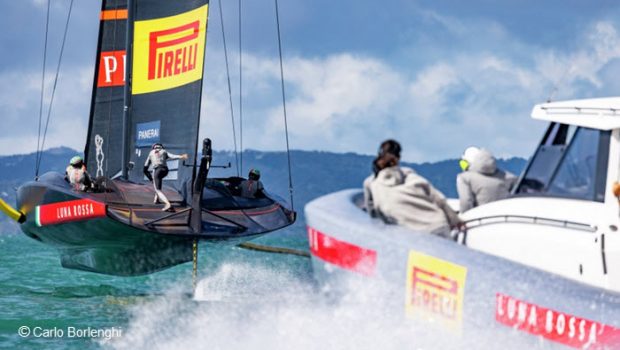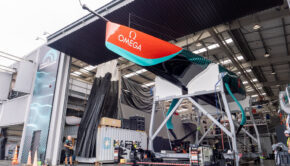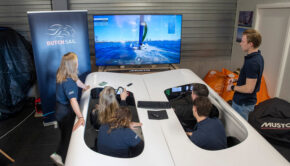Using technology for onboard comms
Published on June 22nd, 2021
During the 36th America’s Cup, one of the revelations for how each team approached the new AC75 Class was how they mapped out the crew responsibilities. All four teams did it differently, but they all needed to overcome the challenge of crew communication on a boat that sails at triple the wind speed.
Scuttlebutt sponsor Vokkero provided the hands free wireless technology for the crew communication on America’s Cup challenger American Magic, and in this report by the Italian Luna Rossa team, they reveal the importance of this technology:
When flying at 50 knots speed, communications on a boat like the AC75 are not that simple. Wind, noises, and vibrations from the hull and rig are all elements that disturb the communication flow.
On Luna Rossa, the only sailor who could move from one side of the boat to the other during navigation, passing on the stern, was mainsail trimmer and strategist Pietro Sibello. Both Jimmy Spithill and Checco Bruni, in their alternating roles of helmsmen and flight controllers, did not move from their positions, nor did the other eight sailors.
The crew was positioned in two “corridors”, separated by the soft wing that creates a longitudinal barrier between the two sides of the hull and prevented the crew on one side from seeing what happened during the maneuvers on the opposite side.
The distance between the first man at bow and the last one at the stern is about 15 meters, a condition that made it virtually impossible to communicate without specific aids. All maneuvers are called and executed in a matter of seconds, so it is essential that each crew member receives clear and precise information simultaneously.
For this reason it has been necessary to develop an advanced intercom system for on-board communication on the AC75 and with the support boats.
The system is positioned in the helmets of each sailor that are fitted with sophisticated microphones and earphones. The crew interacts within the boat and with the support fleet on single radio channel. Everyone onboard can listen, but only a select few can use the microphone.
The helmsmen, the mainsail/strategist and jib trimmers, who need to exchange information on handling, sail trimming, and the racecourse conditions are enabled to communicate verbally. Gilberto Nobili is also enabled for this function, as he provides the afterguard with the information displayed on the racing software, such as the approach times to the starting line and to the laylines.
During training and sea trials, the team members on the support boats can communicate with the sailing team. In particular, the coach, technicians, and engineers monitoring the data of the sensors mounted on the AC75 listen to the comments from the sailors through their headphones and interact continuously with them. During the regattas, the rule prohibits any kind of external assistance, so intercoms of the support boats are disabled a few minutes before the start until the end of the race, and the team support assumes a “listen-only” mode.
All boats competing can only communicate with the Race Director for information related to the race and with the Umpires, the judges who supervise the regatta, to acknowledge the protests and assign penalties. On Luna Rossa, Checco Bruni and Jimmy Spithill are the crew members who interact with the organization.









 We’ll keep your information safe.
We’ll keep your information safe.